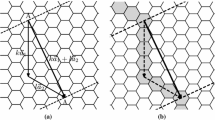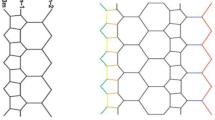The present article is the first part of a series devoted to extending the Repeat Space Theory (RST) to apply to carbon nanotubes and related molecular networks. Four key problems are formulated whose affirmative solutions imply the formation of the initial investigative bridge between the research field of nanotubes and that of the additivity and other network problems studied and solved by using the RST. All of these four problems are solved affirmatively by using tools from the RST. The Piecewise Monotone Lemmas (PMLs) are cornerstones of the proof of the Fukui conjecture concerning the additivity problems of hydrocarbons. The solution of the fourth problem gives a generalized analytical formula of the pi-electron energy band curves of nanotube (a, b), with two new complex parameters c and d. These two parameters bring forth a broad class of analytic curves to which the PMLs and associated theoretical devices apply. Based on the above affirmative solutions of the problems, a central theorem in the RST, called the asymptotic linearity theorem (ALT) has been applied to nanotubes and monocyclic polyenes. Analytical formulae derived in this application of the ALT illuminate in a new global context (i) the conductivity of nanotubes and (ii) the aromaticity of monocyclic polyenes; moreover an analytical formula obtained by using the ALT provides a fresh insight into Hückel’s (4n+2) rule. The present article forms a foundation of the forthcoming articles in this series.
Similar content being viewed by others
References
Arimoto S. (2003). Note on the repeat space theory – its development and communications with Prof. Kenichi Fukui-. J. Math. Chem. 34:253
Arimoto S. (2003). New proof of the Fukui conjecture by the Functional Asymptotic Linearity Theorem. J. Math. Chem. 34:259
Arimoto S. (2003). The Functional Delta Existence Theorem and the reduction of a proof of the Fukui conjecture to that of the Special Functional Asymptotic Linearity Theorem, J. Math. Chem. 34:287
Arimoto S., and Fukui K., Fundamental Mathematical Chemistry, Interdisciplinary Research in Fundamental Mathematical Chemistry and Generalized Repeat Space, IFC Bulletin 1998, pp. 7–13.
Arimoto S., Fukui K., Taylor K.F., and Mezey P.G. (1998). Int. J. Quantum Chem 67:57
Arimoto S., Fukui K., Zizler P., Taylor K.F., and Mezey P.G. (1999). Int. J. Quantum Chem 74:633
Arimoto S., Spivakovsky M., Ohno H., Zizler P., Taylor K.F., Yamabe T. and Mezey P.G. (2001). Int. J. Quantum Chem. 84:389
Arimoto S., Spivakovsky M., Ohno H., Zizler P., Zuidwijk R.A., Taylor K.F., Yamabe T., and Mezey P.G. (2004). Int. J. Quantum Chem 97:765
Arimoto S., Private communication (2005).
Yamabe T. (1995). Synthetic Metals 70:1511
Arimoto S., A study of the theoretical foundations for the correlation between structure and properties in molecules having many identical moieties (Doctoral Thesis, Department of Hydrocarbon Chemistry, Faculty of Engineering, Kyoto University, 1987).
Arimoto S. (1985). Phys Lett 113A:126
Arimoto S., and Spivakovsky M. (1993). J. Math. Chem 13:217
Arimoto S., Spivakovsky M., Taylor K.F., and Mezey P.G. (2005). J. Math. Chem 37:75
Arimoto S., Spivakovsky M., Taylor K.F., and Mezey P.G. (2005). J. Math. Chem 37:171
Tanaka K., Ago H., Yamabe T., Okahara K., and Okada M. (1997). Int. J. Quantum Chem 63:637
Okahara K., Tanaka K., Aoki H., Sato T., and Yamabe T. (1994). Chem. Phys. Lett 219:462
Lancaster P., and Tismenetsky M. (1985). The Theory of Matrices with Applications. Academic Press, New York
Graham A. (1981). Kronecker Products and Matrix Calculus with Applications. John Wiley, New York
Hall G.G. (1963). Matrices and Tensors. Pergamon Press, Oxford
Tadokoro H. (1979). Structure of Crystalline Polymers. John Wiley, New York
Arimoto S., Fukui K., Taylor K.F., and Mezey P.G. (1995). Int. J. Quantum Chem 53:375
Hall G.G. (1955). Proc. Roy. Soc. (London) A 229:251
Hall G.G. (1973). Int. J. Math. Educ. Sci. Technol. 4:233
Hall G.G. (1981). Bull. Inst. Math. Appl 17:70
Arimoto S., and Taylor K.F. (1993). J. Math. Chem 13:249
Arimoto S., Fukui K., Taylor K.F., and Mezey P.G. (1995). Int. J. Quantum Chem 53:387
Arimoto S., Fukui K., Ohno H., Taylor K.F., and Mezey P.G. (1997). Int. J. Quantum Chem 63:149
Fukui K., Possibility of chemical creation of definite-sequence polymers – a contribution to the discussion about the origin of life, in Proceedings of the 5th IFC Symposium (May 26, 1989)
Liu J., Dai H., Hafner J.H., Colbert D.T., Smalley R.E., Tans S.J., and Dekker C. (1997) Nature 385:780
Martel R., Shea H.R., and Avouris P. (1999). Nature 398:299
Sano M., Kamino A., Okamura J. and Shinkai S. (2001). Science 293:1299
Yang L., Jiang J., and Dong J. (2003). Phys. Stat. Sol. (b) 238:115
Sakai K., and Kawazoe Y. (2004). Prog. Theor. Phys 112:369
Arimoto S., and Hall G.G. (1992). Int. J. Quantum Chem. 41:613
Hall G.G., and Arimoto S. (1993). Int. J. Quantum Chem. 45:303
Elliott D. J Austral Math Soc B 40 (E) (1998) E27
Lyness J. (1985). Numer Math. 46:611
Author information
Authors and Affiliations
Corresponding author
Additional information
The present series of articles is closely associated with the series of articles entitled ‘Proof of the Fukui conjecture via resolution of singularities and related methods’ published in the JOMC.
Rights and permissions
About this article
Cite this article
Arimoto, S. Repeat Space Theory Applied to Carbon Nanotubes and Related Molecular Networks. I. J Math Chem 41, 231–269 (2007). https://doi.org/10.1007/s10910-006-9064-2
Received:
Revised:
Published:
Issue Date:
DOI: https://doi.org/10.1007/s10910-006-9064-2
Keywords
- repeat space theory (RST)
- asymptotic linearity theorem (ALT)
- additivity and network problems
- *-algebra
- the Fukui conjecture
- carbon nanotubes
- algebraic and analytic curves
- resolution of singularities




